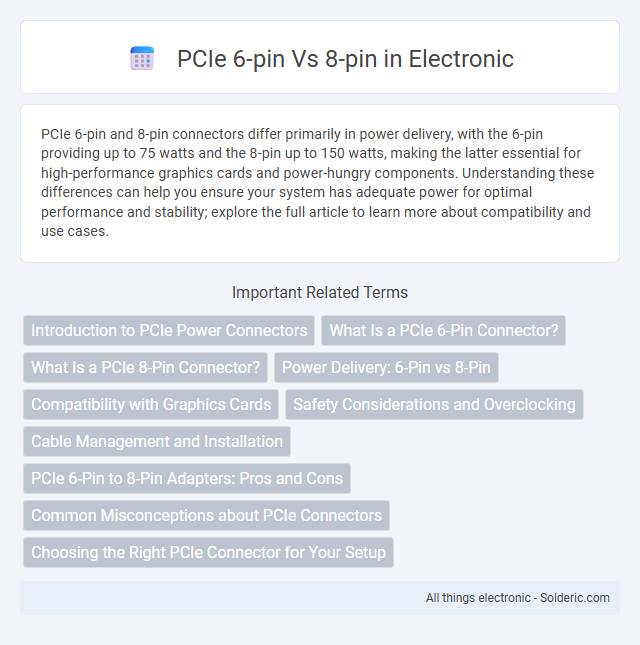PCIe 6-pin and 8-pin connectors differ primarily in power delivery, with the 6-pin providing up to 75 watts and the 8-pin up to 150 watts, making the latter essential for high-performance graphics cards and power-hungry components. Understanding these differences can help you ensure your system has adequate power for optimal performance and stability; explore the full article to learn more about compatibility and use cases.
Comparison Table
| Feature | PCIe 6-Pin | PCIe 8-Pin |
|---|---|---|
| Power Output | Up to 75 Watts | Up to 150 Watts |
| Connector Pins | 6 Pins | 8 Pins |
| Usage | Mid-range GPUs, moderate power devices | High-end GPUs requiring more power |
| Physical Size | Smaller, compact design | Larger, extra pins for power |
| Compatibility | Standard on older GPUs | Common on modern high-performance GPUs |
Introduction to PCIe Power Connectors
PCIe power connectors deliver essential supplementary power to high-performance graphics cards, with 6-pin connectors providing up to 75 watts and 8-pin connectors supporting up to 150 watts. The 6-pin design features three power and three ground wires, while the 8-pin includes an additional two power pins for higher current delivery, ensuring stable operation for demanding GPU workloads. Understanding these differences is crucial for matching power supply capabilities to graphics card requirements and avoiding underpowered systems.
What Is a PCIe 6-Pin Connector?
A PCIe 6-pin connector delivers up to 75 watts of power to your graphics card or other components, essential for maintaining stable performance in mid-range GPUs. This connector features six pins arranged in a 3x2 layout, designed to safely supply additional power beyond what the motherboard provides. Understanding this allows you to ensure your power supply unit has the correct connectors for your hardware needs.
What Is a PCIe 8-Pin Connector?
A PCIe 8-pin connector is a power cable used to deliver up to 150 watts of power to high-performance graphics cards, ensuring stable and sufficient energy supply. Compared to the PCIe 6-pin connector, which provides up to 75 watts, the 8-pin connector features two extra pins to carry additional current needed for demanding GPUs. This connector is essential in modern gaming PCs and workstations to maintain optimal performance and prevent power-related issues during heavy load.
Power Delivery: 6-Pin vs 8-Pin
PCIe 6-pin connectors provide up to 75 watts of power, while 8-pin connectors can deliver up to 150 watts, enabling higher power delivery for demanding GPUs. The additional two pins in the 8-pin connector offer increased current capacity and improved stability, crucial for overclocking and power-intensive applications. Choosing between 6-pin and 8-pin connectors depends on the GPU's power requirements and the overall system power budget.
Compatibility with Graphics Cards
PCIe 6-pin and 8-pin power connectors differ in their power delivery capacities, with 6-pin providing up to 75 watts and 8-pin delivering up to 150 watts, influencing compatibility with high-performance graphics cards. Many modern GPUs require an 8-pin connector or a combination of 6-pin and 8-pin connectors to ensure sufficient power supply during intensive gaming or processing tasks. Adapters are available but using the correct connector recommended by the graphics card manufacturer ensures optimal stability and prevents potential power-related issues.
Safety Considerations and Overclocking
PCIe 6-pin connectors deliver up to 75 watts of power, while 8-pin connectors provide up to 150 watts, making the 8-pin safer for high-power graphics cards and overclocking scenarios by reducing the risk of overheating and electrical instability. Overclocking demands increased power delivery, which can lead to overheating and potential damage if the connector's capacity is exceeded; therefore, 8-pin connectors are preferred for maintaining system stability and preventing thermal hazards. Ensuring proper cable quality and secure connections is critical for safety and optimal performance during extended overclocking sessions.
Cable Management and Installation
PCIe 6-pin cables typically offer a more straightforward installation process due to their smaller connector size, which can simplify tight cable management in compact PC builds. The 8-pin connectors provide higher power delivery capacity, but their larger footprint may require more careful routing to avoid obstructing airflow and other components. Ensuring proper cable length and modular design in PSU cables can significantly enhance neatness and ease of installation for both 6-pin and 8-pin PCIe connections.
PCIe 6-Pin to 8-Pin Adapters: Pros and Cons
PCIe 6-pin to 8-pin adapters provide a practical solution for connecting power supplies lacking native 8-pin connectors to GPUs requiring 8-pin inputs, ensuring compatibility without immediate PSU upgrades. However, these adapters may limit power delivery, as a 6-pin connector typically supplies up to 75 watts, whereas an 8-pin can deliver up to 150 watts, potentially causing insufficient power and instability under heavy GPU loads. You should carefully assess your GPU's power requirements and PSU capacity before using such adapters to maintain system reliability and performance.
Common Misconceptions about PCIe Connectors
PCIe 6-pin and 8-pin connectors are often misunderstood as interchangeable, but the 8-pin connector delivers up to 150 watts compared to the 6-pin's 75 watts, making it essential for high-power GPUs. A common misconception is that adding an adapter from 6-pin to 8-pin increases power safely, while in reality, exceeding the 6-pin's power rating can cause overheating and hardware damage. Understanding these power limits and ensuring proper connectors match the GPU's requirements is critical for system stability and safety.
Choosing the Right PCIe Connector for Your Setup
Choosing the right PCIe connector depends on your GPU's power requirements, where a 6-pin connector delivers up to 75 watts and an 8-pin connector provides up to 150 watts. High-performance graphics cards typically require 8-pin connectors or a combination of 6-pin and 8-pin to ensure stable power delivery. Selecting the correct connector ensures compatibility and prevents potential electrical issues in your PC build.
PCIe 6-pin vs 8-pin Infographic

 solderic.com
solderic.com